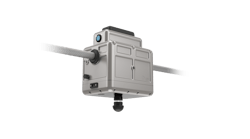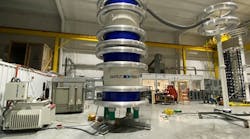Over the past decade, electric utilities have placed increased priority on locating objects and structures that could become energized and pose a shock hazard to the public and animals. One way to locate these energized objects is by using a voltmeter and directly measuring the voltage. Another common technique is to use a pen light that will either alarm or illuminate if the object under test is energized. These techniques are time intensive and expensive to accomplish on a large-scale basis.
Much of the recent detection emphasis has been placed on using mobile scanning and other non-contact methods for identifying electric fields, or E-Fields, that surround all energized objects. Because E-fields are present regardless of whether current is flowing, E-Field detection provides an important means of locating inadvertently energized objects.
To assist electric utilities with their test and measurement programs for detecting and repairing inadvertently energized conductive objects and structures, the Electric Power Research Institute (EPRI) has developed a new type of electric field sensor in collaboration with Consolidated Edison of New York, Long Island Power Authority and National Grid.
The EPRI handheld E-Field sensor detects the electric field lines emanating from charged objects. The unit is similar to other non-contact voltage devices that detect electric fields. But this device represents a key advancement since it has the ability to directionally locate a charged object and contains filtering to optimize its detection sensitivity.
The EPRI E-Field detection unit has been distributed to six utilities to evaluate features, modifications and use capabilities and the feedback will be incorporated into an even more advanced third generation device.
Locating an E-Field
When an E-Field source is created from an overhead transmission circuit, the E-Field will couple voltage potentials onto pipelines and light poles if those conductive objects are in close enough proximity to the E-Field. The same concept holds true for all AC-charged (energized) objects since an electric field is emitted from the charged object and that E-Field can be detected and measured with specialized sensors. The unique part of detecting the E-Field off an inadvertently energized object or surface is that the accuracy of the measurement is unimportant and simply locating the E-Field (where none should be present) is the key requirement.
The strength or intensity of an E-Field is a function of the voltage on the object and the size and shape of the object. As the sensor is moved further away from the field the intensity diminishes. Any metal plate or antenna will pick up a charge from the electric field and if configured with a sensing circuit and amplifiers can provide an indication of both the presence and the intensity (in volts/meter V/m) of the E-Field.
Functionality
The EPRI E-Field meter has a multi LED indicator panel that lights up when it is in close proximity to an object. As the meter moves further away from the object, fewer LEDs appear. The greatest sensitivity is afforded when the tip of the antenna is pointed directly at the charged object. If the device is held in a position 90 degrees to the right of the object and pointing directly at the object, the number of LEDs will change, and display a maximum reading when the unit is pointed directly at (and closest to) the energized object.
Once enough useful field trial feedback is gathered, a future (Beta) version of the meter is planned with a digital signal processor (DSP) chip. The future version should be able to auto-scale for even better sensing and directional capability. Unlike other E-Field sensors, because the detected E-Field wave shape is retained, the Beta version may be able to distinguish between 60-Hz faults and energizations where a return path voltage drop is present. The unit may also be able to locate some energizations before they propagate to the street surface, and filter out some common "false positive" E-Field sources such as neon lights.
Specifications of Handheld E-Field Sensor
Optimal Sensitivity Setting – The unit is calibrated to identify electric field strengths of less than 1 volt per meter. It is not the actual voltage that is detected, but rather the intensity of the electric field lines that propagate out from the charged object. This means that on a large object (like a street light) the unit may pick up a 1Vac field as far as six meters or further away from the light.
Zero to Ten Red LED display – To optimize the volts-per-meter range and the subsequent directional ability of the unit, the red multi LED indicator panel displays sensitivity on a semi log scale. This means that the unit is more difficult to saturate (all LEDs lit) as compared to a linear scale. More lighted LEDs will indicate one of three scenarios.
- A higher voltage on an energized object, when more than one object is energized and they are equal distances apart.
- Closer proximity to any given energized object in an ideal (single charged object) situation.
- The identification of a larger object in terms of conductive surface area and distance away from the earth, such as a street light.
On/Off indicator – The current version has an on off switch on top of the device and has a green LED indicating the unit is on. If the green indicator light does not light up, the unit needs to be recharged.
Charger Port – The unit has a charger port for the rechargeable Lithium-ion battery. In an emergency the unit can be used with a 9-volt alkaline battery.
Charge Time – When the batteries are fully discharged, it takes about 1.25 hours to recharge the unit, using either the vehicle or the wall charger, and the unit should be ready for 20 plus hours of operation once it has been recharged.
Storage – Once the unit has been recharged it is a good idea to push the on/off switch and make sure the green LED turns on and off as the button is pressed. The unit should be stored with the green LED off, otherwise the batteries will slowly discharge.
Calibrator/Tester - A separate calibrator tester may be used to confirm proper LED operation. The calibrator will confirm to the user that the unit is not only operational, but is actually working as designed for optimal directional sensitivity.
Using the Calibrator/Tester – Before using the unit in the field, the operator can plug the calibration unit into the antenna port on the handheld unit and confirm that the handheld unit is working correctly.
Technology Design Summary
Using the standard off-the-shelf monopole antenna along with the inverting amplifier technology, the overall system is flexible for a number of applications. The prototype handheld unit is capable of picking up energized objects down to just a few volts AC with excellent directional quantification.
There were also numerous refinements made after an initial round of field testing to make the unit more sensitive to real energizations and less sensitive to false positives. One such design enhancement was a static-charge walking filter. This filter is used to make the handheld version of the technology less prone to LED bounce when walking.
A second component of the field evaluation was a comparison to other available handheld E-Field meters. This comparison suggests that the EPRI handheld meter is approximately four times more sensitive in terms of picking up and directionally identifying a 60-Hz energization. A third enhancement to the device was the use of a log scale, which makes the unit more sensitive to small fields and less sensitive to larger field strengths. This ultimately provides the user with optimal sensitivity without losing the directional capability because the field-strength indicator needle is ten times harder to max out compared to the first prototype.

